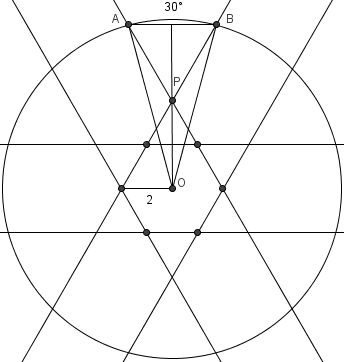2006 AMC 12A Problems/Problem 22
Problem
A circle of radius ![]() is concentric with and outside a regular hexagon of side length
is concentric with and outside a regular hexagon of side length ![]() . The probability that three entire sides of hexagon are visible from a randomly chosen point on the circle is
. The probability that three entire sides of hexagon are visible from a randomly chosen point on the circle is ![]() . What is
. What is ![]() ?
?
![]()
![]()
Solution
Project any two non-adjacent and non-opposite sides of the hexagon to the circle; the arc between the two points formed is the location where all three sides of the hexagon can be fully viewed. Since there are six such pairs of sides, there are six arcs. The probability of choosing a point is ![]() , or if the total arc degree measures add up to
, or if the total arc degree measures add up to ![]() . Each arc must equal
. Each arc must equal ![]() .
.
Call the center ![]() , and the two endpoints of the arc
, and the two endpoints of the arc ![]() and
and ![]() , so
, so ![]() . Let
. Let ![]() be the intersections of the projections of the sides of the hexagon corresponding to
be the intersections of the projections of the sides of the hexagon corresponding to ![]() . Notice that
. Notice that ![]() is an isosceles triangle:
is an isosceles triangle: ![]() and
and ![]() . Since
. Since ![]() is a radius and
is a radius and ![]() can be found in terms of a side of the hexagon, we are almost done.
can be found in terms of a side of the hexagon, we are almost done.
If we draw the altitude of ![]() from
from ![]() , then we get a right triangle. Using simple trigonometry,
, then we get a right triangle. Using simple trigonometry, ![]() .
.
Since ![]() , we get
, we get  .
.
See also
| 2006 AMC 12A (Problems • Answer Key • Resources) | |
| Preceded by Problem 21 |
Followed by Problem 23 |
| 1 • 2 • 3 • 4 • 5 • 6 • 7 • 8 • 9 • 10 • 11 • 12 • 13 • 14 • 15 • 16 • 17 • 18 • 19 • 20 • 21 • 22 • 23 • 24 • 25 | |
| All AMC 12 Problems and Solutions | |










